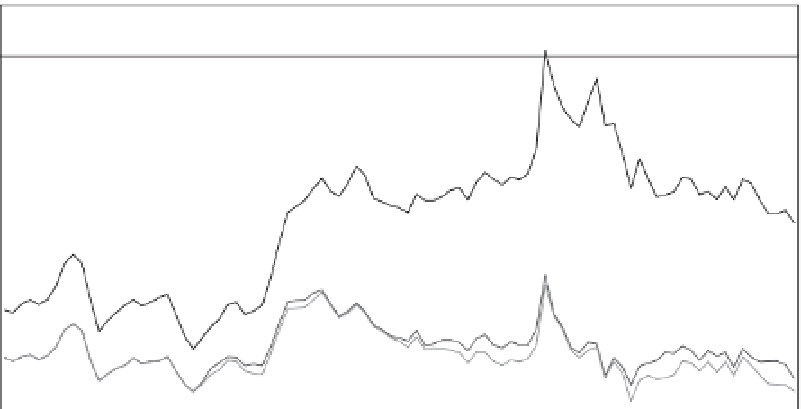Agriculture Reference
In-Depth Information
400
350
300
250
200
150
100
50
0
Total sales
Net income
Adjusted production income
Fig. 12.2.
Real US agricultural sales and income, 1910-2002.
technologies. As explained by Levins and
Cochrane (1996), 'early adopters make profits
for a short while because of their low unit pro-
duction costs. As more farmers adopt the tech-
nology, however, production goes up, prices go
down, and profits are no longer possible even
with the lower production costs'. In this era of
global markets for most commodities, what is
often driving the adoption of new technologies
by US producers is the need to compete with foreign
suppliers - especially those in less-developed
countries - who have lower production input
costs. This competition is resulting in increased
output, but lower profit margins for producers as
they continually search for a profitable niche.
That search has mostly involved seeking produc-
tion methods that give higher yields, despite the
long-run effects on the environment - i.e. in the
past the environment has been viewed by many
as an obstacle to be overcome in the search for
greater output.
Blank's (2008) third result shows which
farms receive government payments and where
those farms are located. He argues that subsidiz-
ing market profits for commodities was a rea-
sonable approach to achieving the goals of
aiding the farm economy during the Great
Depression of the 1930s and lowering food costs
for consumers during the 1940s and 1950s.
Unfortunately, those policies led directly to the
surplus production that depressed commodity
prices and profits over the last few decades thus
hurting farmers to the benefit of domestic and
foreign consumers of US agricultural commodi-
ties. Clearly, a change in focus is needed in US
agricultural policy.
In light of these results concerning the
profitability of US agriculture, the question
arises: 'how can economic viability be estab-
lished so the sustainable agriculture goal can be
achieved?' The answer to this important ques-
tion depends on an understanding of the mar-
kets for agricultural commodities, as explained
below.
Vertical Coordination in Agriculture
The structure, conduct and performance of US
agriculture are continually changing. This may
be most easily seen in agribusiness industries
where firms are becoming larger and more
industrialized, causing industries to become
more concentrated. This change in agribusi-
ness's structure is being driven partly by econo-
mies of scale. Conversely, the location-specific
nature of agricultural production (which is
driven by the comparative advantage of natural






























































































































